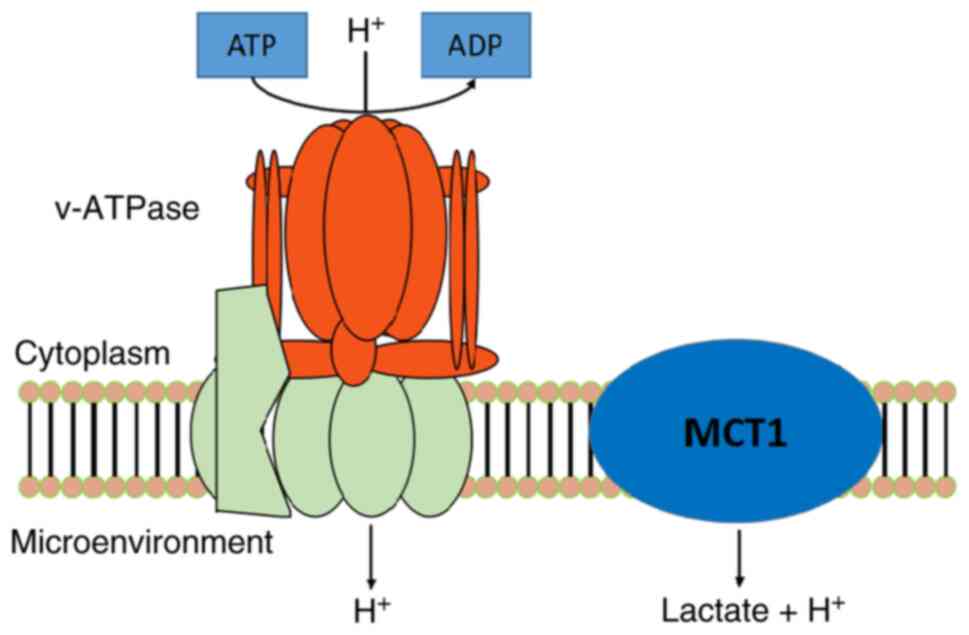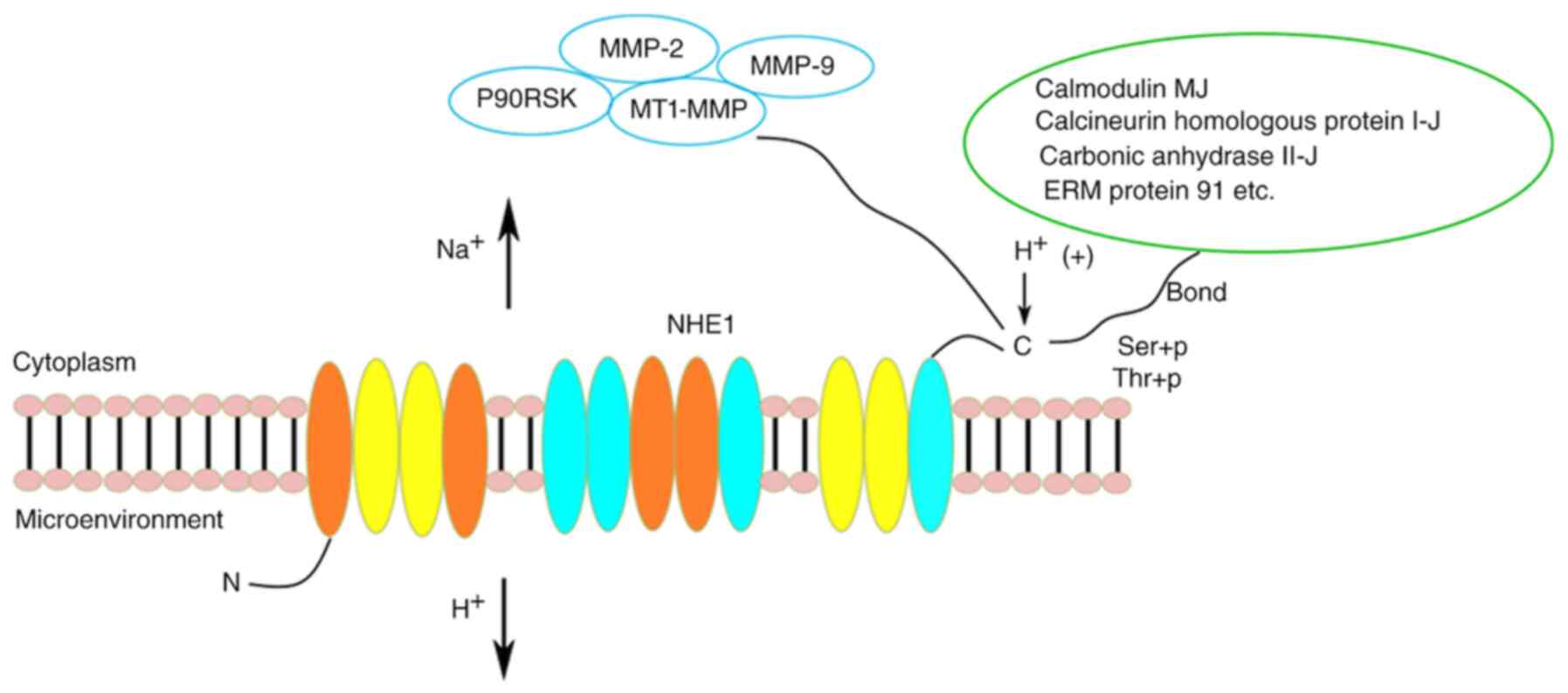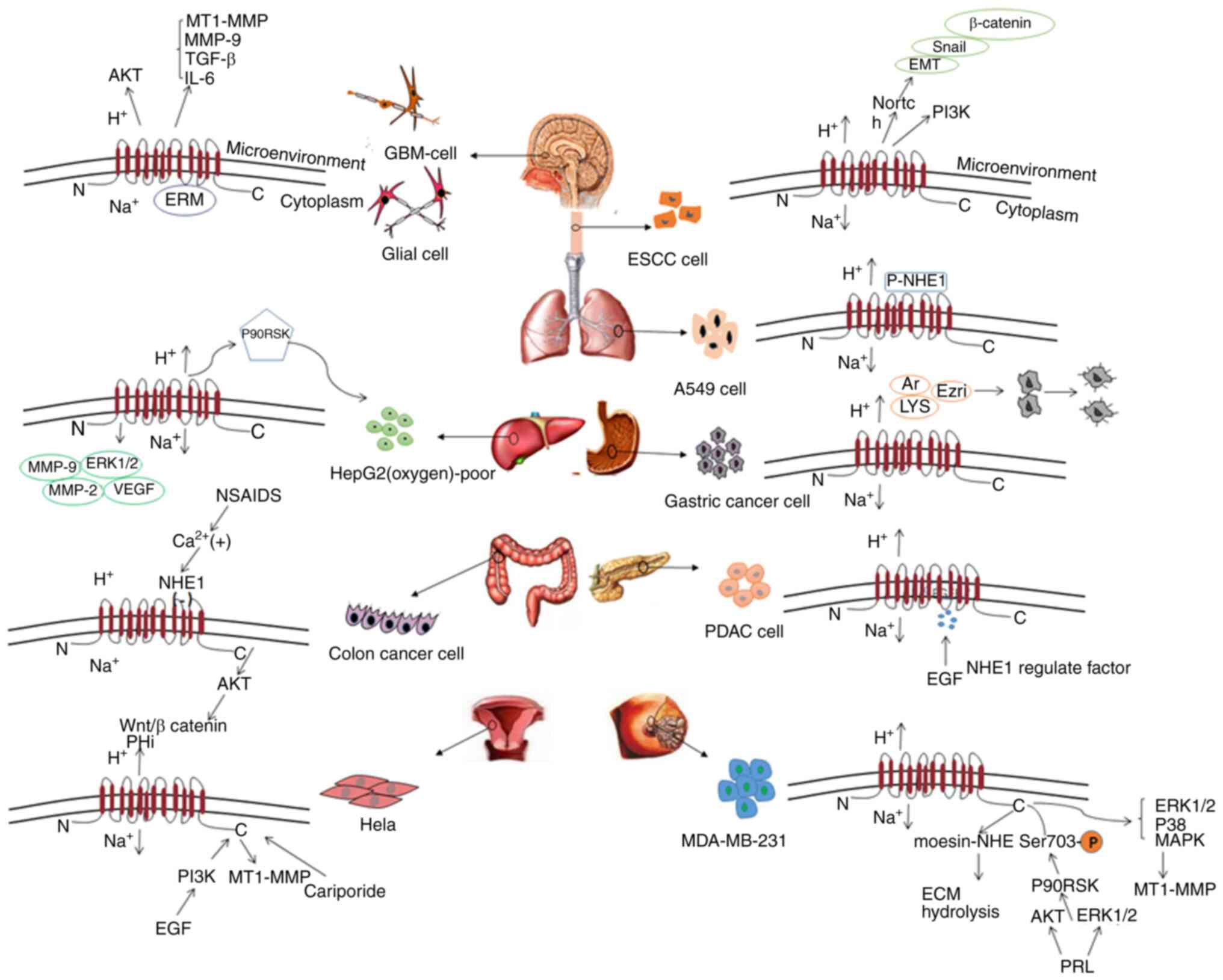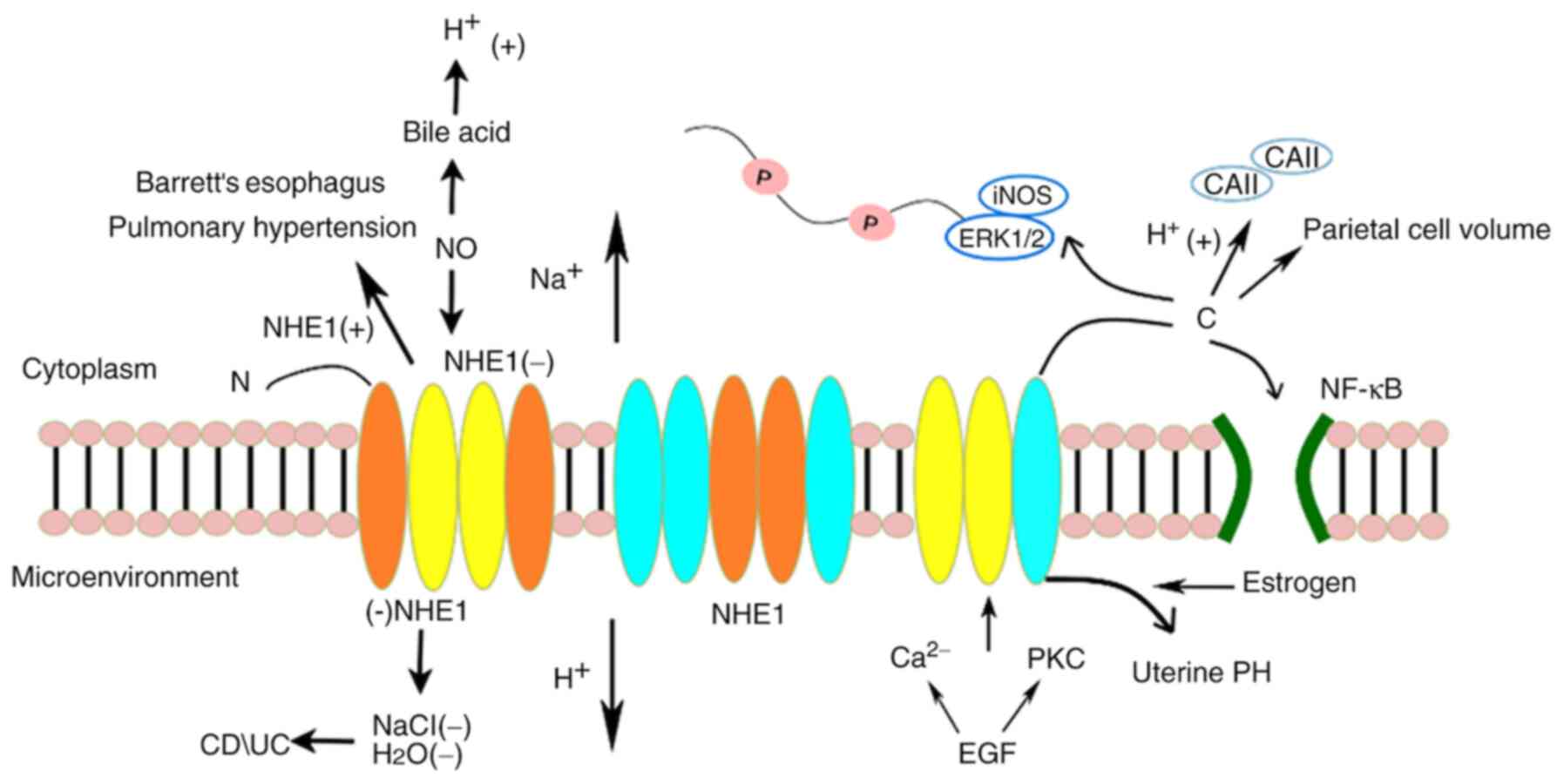|
1
|
Reshkin SJ, Bellizzi A, Caldeira S,
Albarani V, Malanchi I, Poignee M, Alunni-Fabbroni M, Casavola V
and Tommasino M: Na+/H+ exchanger-dependent
intracellular alkalinization is an early event in malignant
transformation and plays an essential role in the development of
subsequent transformation-associated phenotypes. FASEB J.
14:2185–2197. 2000. View Article : Google Scholar : PubMed/NCBI
|
|
2
|
Izumi H, Torigoe T, Ishiguchi H, Uramoto
H, Yoshida Y, Tanabe M, Ise T, Murakami T, Yoshida T, Nomoto M and
Kohno K: Cellular pH regulators: Potentially promising molecular
targets for cancer chemotherapy. Cancer Treat Rev. 29:541–549.
2003. View Article : Google Scholar : PubMed/NCBI
|
|
3
|
Li L, Wang YY, Zhao ZS and Ma J: Ezrin is
associated with gastric cancer progression and prognosis. Pathol
Oncol Res. 17:909–915. 2011. View Article : Google Scholar : PubMed/NCBI
|
|
4
|
Yang X, Wang D, Dong W, Song Z and Dou K:
Expression and modulation of Na(+) /H(+) exchanger 1 gene in
hepatocellular carcinoma: A potential therapeutic target. J
Gastroenterol Hepatol. 26:364–370. 2011. View Article : Google Scholar : PubMed/NCBI
|
|
5
|
Brisson L, Reshkin SJ, Gore J and Roger S:
pH regulators in invadosomal functioning: Proton delivery for
matrix tasting. Eur J Cell Biol. 91:847–860. 2012. View Article : Google Scholar : PubMed/NCBI
|
|
6
|
McGuire C, Cotter K, Stransky L and Forgac
M: Regulation of V-ATPase assembly and function of V-ATPases in
tumor cell invasiveness. Biochim Biophys Acta. 1857:1213–1218.
2016. View Article : Google Scholar : PubMed/NCBI
|
|
7
|
Payen VL, Mina E, Van Hée VF, Porporato PE
and Sonveaux P: Monocarboxylate transporters in cancer. Mol Metab.
33:48–66. 2020. View Article : Google Scholar : PubMed/NCBI
|
|
8
|
Dibrov P and Fliegel L: Comparative
molecular analysis of Na+/H+ exchangers: A
unified model for Na+/H+ antiport? FEBS Lett.
424:1–5. 1998. View Article : Google Scholar : PubMed/NCBI
|
|
9
|
Putney LK, Denker SP and Barber DL: The
changing face of the Na+/H+ exchanger, NHE1:
Structure, regulation, and cellular actions. Annu Rev Pharmacol
Toxicol. 42:527–552. 2002. View Article : Google Scholar : PubMed/NCBI
|
|
10
|
Malo ME and Fliegel L: Physiological role
and regulation of the Na+/H+ exchanger. Can J
Physiol Pharmacol. 84:1081–1095. 2006. View
Article : Google Scholar : PubMed/NCBI
|
|
11
|
Landau M, Herz K, Padan E and Ben-Tal N:
Model structure of the Na+/H+ exchanger 1
(NHE1): Functional and clinical implications. J Biol Chem.
282:37854–37863. 2007. View Article : Google Scholar : PubMed/NCBI
|
|
12
|
Noel J, Roux D and Pouyssegur J:
Differential localization of Na+/H+ exchanger
isoforms (NHE1 and NHE3) in polarized epithelial cell lines. J Cell
Sci. 109:929–939. 1996.PubMed/NCBI
|
|
13
|
Orlowski J, Kandasamy RA and Shull GE:
Molecular cloning of putative members of the Na/H exchanger gene
family. cDNA cloning, deduced amino acid sequence, and mRNA tissue
expression of the rat Na/H exchanger NHE-1 and two structurally
related proteins. J Biol Chem. 267:9331–9339. 1992. View Article : Google Scholar : PubMed/NCBI
|
|
14
|
Nakamura N, Tanaka S, Teko Y, Mitsui K and
Kanazawa H: Four Na+/H+ exchanger isoforms
are distributed to Golgi and post-Golgi compartments and are
involved in organelle pH regulation. J Biol Chem. 280:1561–1572.
2005. View Article : Google Scholar : PubMed/NCBI
|
|
15
|
Pedersen SF, O'Donnell ME, Anderson SE and
Cala PM: Physiology and pathophysiology of
Na+/H+ exchange and Na+
-K+ −2Cl- cotransport in the heart, brain, and blood. Am
J Physiol Regul Integr Comp Physiol. 291:R1–R25. 2006. View Article : Google Scholar : PubMed/NCBI
|
|
16
|
Denker SP, Huang DC, Orlowski J, Furthmayr
H and Barber DL: Direct binding of the Na-H exchanger NHE1 to ERM
proteins regulates the cortical cytoskeleton and cell shape
independently of H(+) translocation. Mol Cell. 6:1425–1436. 2000.
View Article : Google Scholar : PubMed/NCBI
|
|
17
|
Loo SY, Chang MK, Chua CS, Kumar AP,
Pervaiz S and Clement MV: NHE-1: A promising target for novel
anti-cancer therapeutics. Curr Pharm Des. 18:1372–1382. 2012.
View Article : Google Scholar : PubMed/NCBI
|
|
18
|
Koslová A, Trefil P, Mucksová J, Reinišová
M, Plachý J, Kalina J, Kučerová D, Geryk J, Krchlíková V, Lejčková
B and Hejnar J: Precise CRISPR/Cas9 editing of the NHE1 gene
renders chickens resistant to the J subgroup of avian leukosis
virus. Proc Natl Acad Sci USA. 117:2108–2112. 2020. View Article : Google Scholar : PubMed/NCBI
|
|
19
|
Reshkin SJ, Cardone RA and Harguindey S:
Na+-H+ exchanger, pH regulation and cancer.
Recent Pat Anticancer Drug Discov. 8:85–99. 2013. View Article : Google Scholar : PubMed/NCBI
|
|
20
|
Keurhorst D, Liashkovich I, Frontzek F,
Nitzlaff S, Hofschröer V, Dreier R and Stock C: MMP3 activity
rather than cortical stiffness determines NHE1-dependent
invasiveness of melanoma cells. Cancer Cell Int. 19:2852019.
View Article : Google Scholar : PubMed/NCBI
|
|
21
|
Lucien F, Brochu-Gaudreau K, Arsenault D,
Harper K and Dubois CM: Hypoxia-induced invadopodia formation
involves activation of NHE-1 by the p90 ribosomal S6 kinase
(p90RSK). PLoS One. 6:e288512011. View Article : Google Scholar : PubMed/NCBI
|
|
22
|
Kato Y, Lambert CA, Colige AC, Mineur P,
Noël A, Frankenne F, Foidart JM, Baba M, Hata R, Miyazaki K and
Tsukuda M: Acidic extracellular pH induces matrix
metalloproteinase-9 expression in mouse metastatic melanoma cells
through the phospholipase D-mitogen-activated protein kinase
signaling. J Biol Chem. 280:10938–10944. 2005. View Article : Google Scholar : PubMed/NCBI
|
|
23
|
Lin Y, Chang G, Wang J, Jin W, Wang L, Li
H, Ma L, Li Q and Pang T: NHE1 mediates MDA-MB-231 cells invasion
through the regulation of MT1-MMP. Exp Cell Res. 317:2031–2040.
2011. View Article : Google Scholar : PubMed/NCBI
|
|
24
|
Poincloux R, Lizarraga F and Chavrier P:
Matrix invasion by tumour cells: A focus on MT1-MMP trafficking to
invadopodia. J Cell Sci. 122:3015–3024. 2009. View Article : Google Scholar : PubMed/NCBI
|
|
25
|
Caldieri G and Buccione R: Aiming for
invadopodia: Organizing polarized delivery at sites of invasion.
Trends Cell Biol. 20:64–70. 2010. View Article : Google Scholar : PubMed/NCBI
|
|
26
|
Cougoule C, Carreno S, Castandet J,
Labrousse A, Astarie-Dequeker C, Poincloux R, Le Cabec V and
Maridonneau-Parini I: Activation of the lysosome-associated p61Hck
isoform triggers the biogenesis of podosomes. Traffic. 6:682–694.
2005. View Article : Google Scholar : PubMed/NCBI
|
|
27
|
Stuart-Tilley A, Sardet C, Pouyssegur J,
Schwartz MA, Brown D and Alper SL: Immunolocalization of anion
exchanger AE2 and cation exchanger NHE-1 in distinct adjacent cells
of gastric mucosa. Am J Physiol. 266:C559–C568. 1994. View Article : Google Scholar : PubMed/NCBI
|
|
28
|
Rossmann H, Sonnentag T, Heinzmann A,
Seidler B, Bachmann O, Vieillard-Baron D, Gregor M and Seidler U:
Differential expression and regulation of Na(+)/H(+) exchanger
isoforms in rabbit parietal and mucous cells. Am J Physiol
Gastrointest Liver Physiol. 281:G447–G458. 2001. View Article : Google Scholar : PubMed/NCBI
|
|
29
|
Bachmann O, Heinzmann A, Mack A, Manns MP
and Seidler U: Mechanisms of secretion-associated shrinkage and
volume recovery in cultured rabbit parietal cells. Am J Physiol
Gastrointest Liver Physiol. 292:G711–G717. 2007. View Article : Google Scholar : PubMed/NCBI
|
|
30
|
Niu YY, Yu PW, Tang B, Shi Y and Hao YX:
Expression of Na+-H+ exchanger 1 in human
gastric carcinoma tissue and its clinical significance. Zhonghua
Wei Chang Wai Ke Za Zhi. 13:604–607. 2010.(In Chinese). PubMed/NCBI
|
|
31
|
Liu HF, Teng XC, Zheng JC, Chen G and Wang
XW: Effect of NHE1 antisense gene transfection on the biological
behavior of SGC-7901 human gastric carcinoma cells. World J
Gastroenterol. 14:2162–2167. 2008. View Article : Google Scholar : PubMed/NCBI
|
|
32
|
Xie R, Wang H, Jin H, Wen G, Tuo B and Xu
J: NHE1 is upregulated in gastric cancer and regulates gastric
cancer cell proliferation, migration and invasion. Oncol Rep.
37:1451–1460. 2017. View Article : Google Scholar : PubMed/NCBI
|
|
33
|
Wu D and Qi J: Mechanisms of the
beneficial effect of NHE1 inhibitor in traumatic hemorrhage:
Inhibition of inflammatory pathways. Resuscitation. 83:774–781.
2012. View Article : Google Scholar : PubMed/NCBI
|
|
34
|
Yang X, Wang D, Dong W, Song Z and Dou K:
Over-expression of Na+/H+ exchanger 1 and its
clinicopathologic significance in hepatocellular carcinoma. Med
Oncol. 27:1109–1113. 2010. View Article : Google Scholar : PubMed/NCBI
|
|
35
|
Xu J, Ji B, Wen G, Yang Y, Jin H, Liu X,
Xie R, Song W, Song P, Dong H and Tuo B:
Na+/H+ exchanger 1,
Na+/Ca2+ exchanger 1 and calmodulin complex
regulates interleukin 6-mediated cellular behavior of human
hepatocellular carcinoma. Carcinogenesis. 37:290–300. 2016.
View Article : Google Scholar : PubMed/NCBI
|
|
36
|
Yang X, Wang D, Dong W, Song Z and Dou K:
Inhibition of Na(+)/H(+) exchanger 1 by 5-(N-ethyl-N-isopropyl)
amiloride reduces hypoxia-induced hepatocellular carcinoma invasion
and motility. Cancer Lett. 295:198–204. 2010. View Article : Google Scholar : PubMed/NCBI
|
|
37
|
Yang X, Wang D, Dong W, Song Z and Dou K:
Suppression of Na+/H + exchanger 1 by RNA
interference or amiloride inhibits human hepatoma cell line
SMMC-7721 cell invasion. Med Oncol. 28:385–390. 2011. View Article : Google Scholar : PubMed/NCBI
|
|
38
|
Xu L, Fukumura D and Jain RK: Acidic
extracellular pH induces vascular endothelial growth factor (VEGF)
in human glioblastoma cells via ERK1/2 MAPK signaling pathway:
Mechanism of low pH-induced VEGF. J Biol Chem. 277:11368–11374.
2002. View Article : Google Scholar : PubMed/NCBI
|
|
39
|
Hardonnière K, Saunier E, Lemarié A,
Fernier M, Gallais I, Héliès-Toussaint C, Mograbi B, Antonio S,
Bénit P, Rustin P, et al: The environmental carcinogen
benzo[a]pyrene induces a Warburg-like metabolic reprogramming
dependent on NHE1 and associated with cell survival. Sci Rep.
6:307762016. View Article : Google Scholar : PubMed/NCBI
|
|
40
|
Wang J, Tian L, Khan MN, Zhang L, Chen Q,
Zhao Y, Yan Q, Fu L and Liu J: Ginsenoside Rg3 sensitizes hypoxic
lung cancer cells to cisplatin via blocking of NF-κB mediated
epithelial-mesenchymal transition and stemness. Cancer Lett.
415:73–85. 2018. View Article : Google Scholar : PubMed/NCBI
|
|
41
|
Kim SW, Cha MJ, Lee SK, Song BW, Jin X,
Lee JM, Park JH and Lee JD: Curcumin treatment in combination with
glucose restriction inhibits intracellular alkalinization and tumor
growth in hepatoma cells. Int J Mol Sci. 20:23752019. View Article : Google Scholar
|
|
42
|
Li T and Tuo B: Pathophysiology of hepatic
Na+/H+ exchange (Review). Exp Ther Med.
20:1220–1229. 2020. View Article : Google Scholar : PubMed/NCBI
|
|
43
|
Roussa E, Alper SL and Thévenod F:
Immunolocalization of anion exchanger AE2, Na(+)/H(+) exchangers
NHE1 and NHE4, and vacuolar type H(+)-ATPase in rat pancreas. J
Histochem Cytochem. 49:463–474. 2001. View Article : Google Scholar : PubMed/NCBI
|
|
44
|
Lee MG, Ahn W, Choi JY, Luo X, Seo JT,
Schultheis PJ, Shull GE, Kim KH and Muallem S: Na(+)-dependent
transporters mediate HCO(3)(−) salvage across the luminal membrane
of the main pancreatic duct. J Clin Invest. 105:1651–1658. 2000.
View Article : Google Scholar : PubMed/NCBI
|
|
45
|
Brown DA, Melvin JE and Yule DI: Critical
role for NHE1 in intracellular pH regulation in pancreatic acinar
cells. Am J Physiol Gastrointest Liver Physiol. 285:G804–G812.
2003. View Article : Google Scholar : PubMed/NCBI
|
|
46
|
Cardone RA, Greco MR, Zeeberg K,
Zaccagnino A, Saccomano M, Bellizzi A, Bruns P, Menga M, Pilarsky
C, Schwab A, et al: A novel NHE1-centered signaling cassette drives
epidermal growth factor receptor-dependent pancreatic tumor
metastasis and is a target for combination therapy. Neoplasia.
17:155–166. 2015. View Article : Google Scholar : PubMed/NCBI
|
|
47
|
Wang H, Cai J, Du S, Wei W and Shen X:
LAMC2 modulates the acidity of microenvironments to promote
invasion and migration of pancreatic cancer cells via regulating
AKT-dependent NHE1 activity. Exp Cell Res. 391:1119842020.
View Article : Google Scholar : PubMed/NCBI
|
|
48
|
Siddique I and Khan I: Regulation of Na/H
exchanger-1 in gastroesophageal reflux disease: Possible
interaction of histamine receptor. Dig Dis Sci. 48:1832–1838. 2003.
View Article : Google Scholar : PubMed/NCBI
|
|
49
|
Fujiwara Y, Higuchi K, Takashima T,
Hamaguchi M, Hayakawa T, Tominaga K, Watanabe T, Oshitani N,
Shimada Y and Arakawa T: Roles of epidermal growth factor and
Na+/H+ exchanger-1 in esophageal epithelial
defense against acid-induced injury. Am J Physiol Gastrointest
Liver Physiol. 290:G665–G673. 2006. View Article : Google Scholar : PubMed/NCBI
|
|
50
|
Rastogi A, Puli S, El-Serag HB, Bansal A,
Wani S and Sharma P: Incidence of esophageal adenocarcinoma in
patients with Barrett's esophagus and high-grade dysplasia: A
meta-analysis. Gastrointest Endosc. 67:394–398. 2008. View Article : Google Scholar : PubMed/NCBI
|
|
51
|
Goldman A, Shahidullah M, Goldman D,
Khailova L, Watts G, Delamere N and Dvorak K: A novel mechanism of
acid and bile acid-induced DNA damage involving
Na+/H+ exchanger: Implication for Barrett's
oesophagus. Gut. 59:1606–1616. 2010. View Article : Google Scholar : PubMed/NCBI
|
|
52
|
Guan B, Hoque A and Xu X: Amiloride and
guggulsterone suppression of esophageal cancer cell growth in vitro
and in nude mouse xenografts. Front Biol (Beijing). 9:75–81. 2014.
View Article : Google Scholar : PubMed/NCBI
|
|
53
|
Ariyoshi Y, Shiozaki A, Ichikawa D,
Shimizu H, Kosuga T, Konishi H, Komatsu S, Fujiwara H, Okamoto K,
Kishimoto M, et al: Na+/H+ exchanger 1 has
tumor suppressive activity and prognostic value in esophageal
squamous cell carcinoma. Oncotarget. 8:2209–2223. 2017. View Article : Google Scholar : PubMed/NCBI
|
|
54
|
Kim YS, Yi BR, Kim NH and Choi KC: Role of
the epithelial-mesenchymal transition and its effects on embryonic
stem cells. Exp Mol Med. 46:e1082014. View Article : Google Scholar : PubMed/NCBI
|
|
55
|
Gonzalez DM and Medici D: Signaling
mechanisms of the epithelial-mesenchymal transition. Sci Signal.
7:re82014. View Article : Google Scholar : PubMed/NCBI
|
|
56
|
Bourguignon LY, Singleton PA, Diedrich F,
Stern R and Gilad E: CD44 interaction with
Na+-H+ exchanger (NHE1) creates acidic
microenvironments leading to hyaluronidase-2 and cathepsin B
activation and breast tumor cell invasion. J Biol Chem.
279:26991–27007. 2004. View Article : Google Scholar : PubMed/NCBI
|
|
57
|
Gatenby RA, Smallbone K, Maini PK, Rose F,
Averill J, Nagle RB, Worrall L and Gillies RJ: Cellular adaptations
to hypoxia and acidosis during somatic evolution of breast cancer.
Br J Cancer. 97:646–653. 2007. View Article : Google Scholar : PubMed/NCBI
|
|
58
|
Cardone RA, Casavola V and Reshkin SJ: The
role of disturbed pH dynamics and the Na+/H+
exchanger in metastasis. Nat Rev Cancer. 5:786–795. 2005.
View Article : Google Scholar : PubMed/NCBI
|
|
59
|
Itoh Y and Seiki M: MT1-MMP: A potent
modifier of pericellular microenvironment. J Cell Physiol. 206:1–8.
2006. View Article : Google Scholar : PubMed/NCBI
|
|
60
|
Beaty BT, Wang Y, Bravo-Cordero JJ, Sharma
VP, Miskolci V, Hodgson L and Condeelis J: Talin regulates
moesin-NHE-1 recruitment to invadopodia and promotes mammary tumor
metastasis. J Cell Biol. 205:737–751. 2014. View Article : Google Scholar : PubMed/NCBI
|
|
61
|
Greco MR, Antelmi E, Busco G, Guerra L,
Rubino R, Casavola V, Reshkin SJ and Cardone RA: Protease activity
at invadopodial focal digestive areas is dependent on NHE1-driven
acidic pHe. Oncol Rep. 31:940–946. 2014. View Article : Google Scholar : PubMed/NCBI
|
|
62
|
Pedraz-Cuesta E, Fredsted J, Jensen HH,
Bornebusch A, Nejsum LN, Kragelund BB and Pedersen SF: Prolactin
signaling stimulates invasion via Na(+)/H(+) exchanger NHE1 in T47D
human breast cancer cells. Mol Endocrinol. 30:693–708. 2016.
View Article : Google Scholar : PubMed/NCBI
|
|
63
|
Li X, Quan S, Corsiatto T and Fliegel L:
Acidic residues of extracellular loop 3 of the
Na+/H+ exchanger type 1 are important in
cation transport. Mol Cell Biochem. 468:13–20. 2020. View Article : Google Scholar : PubMed/NCBI
|
|
64
|
Onishi I, Lin PJ, Numata Y, Austin P,
Cipollone J, Roberge M, Roskelley CD and Numata M: Organellar
(Na+, K+)/H+ exchanger NHE7
regulates cell adhesion, invasion and anchorage-independent growth
of breast cancer MDA-MB-231 cells. Oncol Rep. 27:311–317.
2012.PubMed/NCBI
|
|
65
|
Rolver MG, Elingaard-Larsen LO, Andersen
AP, Counillon L and Pedersen SF: Pyrazine ring-based
Na+/H+ exchanger (NHE) inhibitors potently
inhibit cancer cell growth in 3D culture, independent of NHE1. Sci
Rep. 10:58002020. View Article : Google Scholar : PubMed/NCBI
|
|
66
|
Dudeja PK, Hafez N, Tyagi S, Gailey CA,
Toofanfard M, Alrefai WA, Nazir TM, Ramaswamy K and Al-Bazzaz FJ:
Expression of the Na+/H+ and Cl-/HCO-3
exchanger isoforms in proximal and distal human airways. Am J
Physiol. 276:L971–L978. 1999.PubMed/NCBI
|
|
67
|
Al-Bazzaz FJ, Hafez N, Tyagi S, Gailey CA,
Toofanfard M, Alrefai WA, Nazir TM, Ramaswamy K and Dudeja PK:
Detection of Cl-HCO3- and Na+-H+
exchangers in human airways epithelium. JOP. 2 (Suppl 4):S285–S290.
2001.
|
|
68
|
Rios EJ, Fallon M, Wang J and Shimoda LA:
Chronic hypoxia elevates intracellular pH and activates
Na+/H+ exchange in pulmonary arterial smooth
muscle cells. Am J Physiol Lung Cell Mol Physiol. 289:L867–L874.
2005. View Article : Google Scholar : PubMed/NCBI
|
|
69
|
Zhang GZ, Huang GJ, Li WL, Wu GM and Qian
GS: Effect of co-inhibition of MCT1 gene and NHE1 gene on
proliferation and growth of human lung adenocarcinoma cells. Ai
Zheng. 21:719–723. 2002.(In Chinese). PubMed/NCBI
|
|
70
|
Wu GM, Qian GS, Huang GJ, Li SP, Yao W and
Lu JY: The effect of Na(+)/H(+) exchanger-1 (NHE-1) antisense
expression vector on NHE-1 gene expression in human lung
adenocarcinoma cells and its biological significance. Zhonghua Jie
He He Hu Xi Za Zhi. 27:191–194. 2004.(In Chinese). PubMed/NCBI
|
|
71
|
Li S, Bao P, Li Z, Ouyang H, Wu C and Qian
G: Inhibition of proliferation and apoptosis induced by a
Na+/H+ exchanger-1 (NHE-1) antisense gene on
drug-resistant human small cell lung cancer cells. Oncol Rep.
21:1243–1249. 2009.PubMed/NCBI
|
|
72
|
Pizzonia JH, Ransom BR and Pappas CA:
Characterization of Na+/H+ exchange activity
in cultured rat hippocampal astrocytes. J Neurosci Res. 44:191–198.
1996. View Article : Google Scholar : PubMed/NCBI
|
|
73
|
Cong D, Zhu W, Kuo JS, Hu S and Sun D: Ion
transporters in brain tumors. Curr Med Chem. 22:1171–1181. 2015.
View Article : Google Scholar : PubMed/NCBI
|
|
74
|
Wu KL, Khan S, Lakhe-Reddy S, Jarad G,
Mukherjee A, Obejero-Paz CA, Konieczkowski M, Sedor JR and
Schelling JR: The NHE1 Na+/H+ exchanger
recruits ezrin/radixin/moesin proteins to regulate Akt-dependent
cell survival. J Biol Chem. 279:26280–26286. 2004. View Article : Google Scholar : PubMed/NCBI
|
|
75
|
McHardy LM, Sinotte R, Troussard A,
Sheldon C, Church J, Williams DE, Andersen RJ, Dedhar S, Roberge M
and Roskelley CD: The tumor invasion inhibitor dihydromotuporamine
C activates RHO, remodels stress fibers and focal adhesions, and
stimulates sodium-proton exchange. Cancer Res. 64:1468–1474. 2004.
View Article : Google Scholar : PubMed/NCBI
|
|
76
|
Paradiso A, Cardone RA, Bellizzi A,
Bagorda A, Guerra L, Tommasino M, Casavola V and Reshkin SJ: The
Na+-H+ exchanger-1 induces cytoskeletal
changes involving reciprocal RhoA and Rac1 signaling, resulting in
motility and invasion in MDA-MB-435 cells. Breast Cancer Res.
6:R616–R628. 2004. View
Article : Google Scholar : PubMed/NCBI
|
|
77
|
Reshkin SJ, Bellizzi A, Albarani V, Guerra
L, Tommasino M, Paradiso A and Casavola V: Phosphoinositide
3-kinase is involved in the tumor-specific activation of human
breast cancer cell Na(+)/H(+) exchange, motility, and invasion
induced by serum deprivation. J Biol Chem. 275:5361–5369. 2000.
View Article : Google Scholar : PubMed/NCBI
|
|
78
|
Charles NA, Holland EC, Gilbertson R,
Glass R and Kettenmann H: The brain tumor microenvironment. Glia.
59:1169–1180. 2011. View Article : Google Scholar : PubMed/NCBI
|
|
79
|
Zhu W, Carney KE, Pigott VM, Falgoust LM,
Clark PA, Kuo JS and Sun D: Glioma-mediated microglial activation
promotes glioma proliferation and migration: Roles of
Na+/H+ exchanger isoform 1. Carcinogenesis.
37:839–851. 2016. View Article : Google Scholar : PubMed/NCBI
|
|
80
|
Attaphitaya S, Park K and Melvin JE:
Molecular cloning and functional expression of a rat
Na+/H+ exchanger (NHE5) highly expressed in
brain. J Biol Chem. 274:4383–4388. 1999. View Article : Google Scholar : PubMed/NCBI
|
|
81
|
Kurata T, Rajendran V, Fan S, Ohta T,
Numata M and Fushida S: NHE5 regulates growth factor signaling,
integrin trafficking, and degradation in glioma cells. Clin Exp
Metastasis. 36:527–538. 2019. View Article : Google Scholar : PubMed/NCBI
|
|
82
|
Dudeja PK, Rao DD, Syed I, Joshi V, Dahdal
RY, Gardner C, Risk MC, Schmidt L, Bavishi D, Kim KE, et al:
Intestinal distribution of human Na+/H+
exchanger isoforms NHE-1, NHE-2, and NHE-3 mRNA. Am J Physiol.
271:G483–G493. 1996.PubMed/NCBI
|
|
83
|
Khan I, Siddique I, Al-Awadi FM and Mohan
K: Role of Na+/H+ exchanger isoform-1 in
human inflammatory bowel disease. Can J Gastroenterol. 17:31–36.
2003. View Article : Google Scholar : PubMed/NCBI
|
|
84
|
Zachos NC, Tse M and Donowitz M: Molecular
physiology of intestinal Na+/H+ exchange.
Annu Rev Physiol. 67:411–443. 2005. View Article : Google Scholar : PubMed/NCBI
|
|
85
|
Beltran AR, Ramirez MA, Carraro-Lacroix
LR, Hiraki Y, Reboucas NA and Malnic G: NHE1, NHE2, and NHE4
contribute to regulation of cell pH in T84 colon cancer cells.
Pflugers Arch. 455:799–810. 2008. View Article : Google Scholar : PubMed/NCBI
|
|
86
|
Serafino A, Moroni N, Psaila R, Zonfrillo
M, Andreola F, Wannenes F, Mercuri L, Rasi G and Pierimarchi P:
Anti-proliferative effect of atrial natriuretic peptide on
colorectal cancer cells: Evidence for an Akt-mediated cross-talk
between NHE-1 activity and Wnt/β-catenin signaling. Biochim Biophys
Acta. 1822:1004–1018. 2012. View Article : Google Scholar : PubMed/NCBI
|
|
87
|
Iorio J, Duranti C, Lottini T, Lastraioli
E, Bagni G, Becchetti A and Arcangeli A: KV11.1 potassium channel
and the Na+/H+ antiporter NHE1 modulate
adhesion-dependent intracellular pH in colorectal cancer cells.
Front Pharmacol. 11:8482020. View Article : Google Scholar : PubMed/NCBI
|
|
88
|
Rebillard A, Tekpli X, Meurette O, Sergent
O, LeMoigne-Muller G, Vernhet L, Gorria M, Chevanne M, Christmann
M, Kaina B, et al: Cisplatin-induced apoptosis involves membrane
fluidification via inhibition of NHE1 in human colon cancer cells.
Cancer Res. 67:7865–7874. 2007. View Article : Google Scholar : PubMed/NCBI
|
|
89
|
Vaish V and Sanyal SN: Role of Sulindac
and Celecoxib in chemoprevention of colorectal cancer via intrinsic
pathway of apoptosis: Exploring NHE-1, intracellular calcium
homeostasis and Calpain 9. Biomed Pharmacother. 66:116–130. 2012.
View Article : Google Scholar : PubMed/NCBI
|
|
90
|
Lin Y, Wang J, Jin W, Wang L, Li H, Ma L,
Li Q and Pang T: NHE1 mediates migration and invasion of HeLa cells
via regulating the expression and localization of MT1-MMP. Cell
Biochem Funct. 30:41–46. 2012. View Article : Google Scholar : PubMed/NCBI
|
|
91
|
Chiang Y, Chou CY, Hsu KF, Huang YF and
Shen MR: EGF upregulates Na+/H+ exchanger
NHE1 by post-translational regulation that is important for
cervical cancer cell invasiveness. J Cell Physiol. 214:810–819.
2008. View Article : Google Scholar : PubMed/NCBI
|
|
92
|
Loh SH, Tsai YT, Huang SF, Yu TC, Kuo PC,
Chao SC, Chou MF, Tsai CS and Lee SP: Effects of andrographolide on
intracellular pH regulation, cellular migration, and apoptosis in
human cervical cancer cells†. Cancers (Basel). 12:3872020.
View Article : Google Scholar
|
|
93
|
Gholami K, Muniandy S and Salleh N:
Differential expression of Na+/H+-exchanger
(NHE-1, 2, and 4) proteins and mRNA in rodent's uterus under sex
steroid effect and at different phases of the oestrous cycle.
Biomed Res Int. 2013:8401212013. View Article : Google Scholar : PubMed/NCBI
|
|
94
|
Ismail N, Giribabu N, Muniandy S and
Salleh N: Enhanced expression of sodium hydrogen exchanger (NHE)-1,
2 and 4 in the cervix of ovariectomised rats by phytoestrogen
genistein. Int J Med Sci. 12:468–477. 2015. View Article : Google Scholar : PubMed/NCBI
|


















